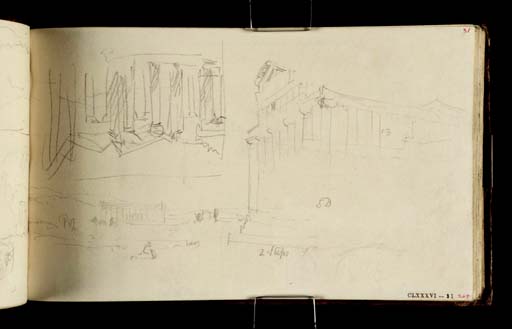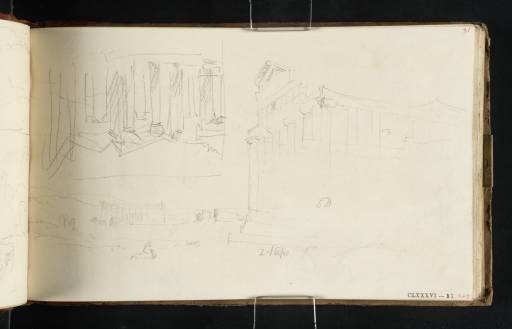Joseph Mallord William Turner Two Sketches at Paestum: the Eastern End of the Temple of Athena (formerly known as the Temple of Ceres); and the Interior of the Second Temple of Hera (formerly known as the Temple of Neptune) 1819
Image 1 of 2
-
 Joseph Mallord William Turner, Two Sketches at Paestum: the Eastern End of the Temple of Athena (formerly known as the Temple of Ceres); and the Interior of the Second Temple of Hera (formerly known as the Temple of Neptune) 1819
Joseph Mallord William Turner, Two Sketches at Paestum: the Eastern End of the Temple of Athena (formerly known as the Temple of Ceres); and the Interior of the Second Temple of Hera (formerly known as the Temple of Neptune) 1819 -
 Joseph Mallord William Turner, Two Sketches at Paestum: the Eastern End of the Temple of Athena (formerly known as the Temple of Ceres); and the Interior of the Second Temple of Hera (formerly known as the Temple of Neptune) 1819 (Enhanced image)Enhanced image
Joseph Mallord William Turner, Two Sketches at Paestum: the Eastern End of the Temple of Athena (formerly known as the Temple of Ceres); and the Interior of the Second Temple of Hera (formerly known as the Temple of Neptune) 1819 (Enhanced image)Enhanced image
Joseph Mallord William Turner,
Two Sketches at Paestum: the Eastern End of the Temple of Athena (formerly known as the Temple of Ceres); and the Interior of the Second Temple of Hera (formerly known as the Temple of Neptune)
1819
Joseph Mallord William Turner 1775–1851
Folio 33 Recto:
Two Sketches at Paestum: the Eastern End of the Temple of Athena (formerly known as the Temple of Ceres); and the Interior of the Second Temple of Hera (formerly known as the Temple of Neptune) 1819
D15972
Turner Bequest CLXXXVI 31
Turner Bequest CLXXXVI 31
Pencil on white wove paper, 113 x 189 mm
Inscribed by the artist in pencil ‘2 Steps’ and ‘50’ and ‘13’ within sketch of temple
Inscribed by ?John Ruskin in red ink ‘31’ top right and ‘245’ bottom right
Stamped in black ‘CLXXXVI 31’ bottom right
Inscribed by ?John Ruskin in red ink ‘31’ top right and ‘245’ bottom right
Stamped in black ‘CLXXXVI 31’ bottom right
Accepted by the nation as part of the Turner Bequest 1856
Exhibition history
1974
Turner 1775–1851, Royal Academy, London, November 1974–March 1975 (232, as ‘Two studies of the Group of Temples at Paestum, with four composition sketches’).
References
1909
A.J. Finberg, A Complete Inventory of the Drawings of the Turner Bequest, London 1909, vol.I, p.552, as ‘Do. [Temple at Pæstum]’.
1974
Martin Butlin, Andrew Wilton and John Gage, Turner 1775–1851, exhibition catalogue, Royal Academy, London 1974, p.91, no.232, as ‘Two studies of the Group of Temples at Paestum, with four composition sketches’.
1983
Cecilia Powell, ‘Turner’s Vignettes and the Making of Rogers’s “Italy”, Turner Studies, Summer 1983, vol.3, no.1, p.8.
1984
Cecilia Powell, ‘Turner on Classic Ground: His Visits to Central and Southern Italy and Related Paintings and Drawings’, unpublished Ph.D thesis, Courtauld Institute of Art, University of London 1984, pp.190 note 91, 425, 535–6 note 26, as ‘The Temple of Ceres with the Temple of Neptune in the distance; and a smaller sketch of the interior of the Temple of Neptune’.
1987
Cecilia Powell, Turner in the South: Rome, Naples, Florence, New Haven and London 1987, p.83 note 71.
1993
Dr Jan Piggott, Turner’s Vignettes, exhibition catalogue, Tate Gallery, London 1993, p.82 under no.7.
This page contains two sketches associated with Turner’s exploration of Paestum, an ancient city on a plain between the Lattari mountains and the Tyrrenhian sea, approximately twenty miles south-east of Salerno. The site was most famous for its three fifth-century BC Greek temples which had been rediscovered at the end of the eighteenth century. The main drawing depicts the eastern end of the Temple of Athena (formerly known as the Temple of Ceres), which as Turner shows has six columns at the front and a surviving fragment of the entablature and pediment.1 In the distance to the left can be seen the relative position of the Second Temple of Hera (formerly known as the Temple of Neptune). For a depiction of the western end of the Temple of Athena see folio 32 verso (D15971; Turner Bequest CLXXXVI 30a).
Inverted in the top left-hand corner of the page is a separate study of the interior of the Second Temple of Hera depicting the surviving remains of the pronaos, or inner portico, at one end.2 Turner used a diagram of a similar view during his perspective lectures at the Royal Academy (see Tate D17072; Turner Bequest CXCV 102), almost certainly based upon an original drawing by Giovanni Battista Piranesi (1720–1778) in the collection of the architect John Soane.3
For a more detailed discussion and other sketches of the temples see folio 31 (D15968; Turner Bequest CLXXXVI 29).
Nicola Moorby
July 2010
How to cite
Nicola Moorby, ‘Two Sketches at Paestum: the Eastern End of the Temple of Athena (formerly known as the Temple of Ceres); and the Interior of the Second Temple of Hera (formerly known as the Temple of Neptune) 1819 by Joseph Mallord William Turner’, catalogue entry, July 2010, in David Blayney Brown (ed.), J.M.W. Turner: Sketchbooks, Drawings and Watercolours, Tate Research Publication, December 2012, https://www

